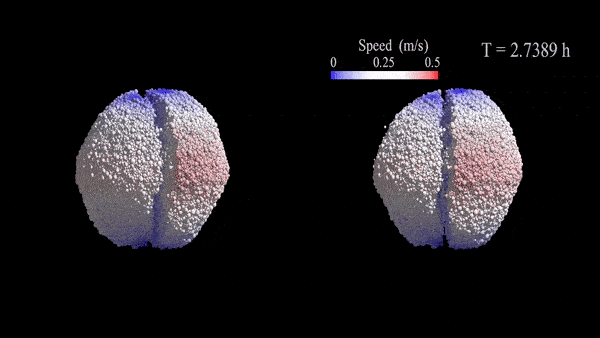
An asteroid disruption event shown here in a stereo gif created by Brian May and Claudia Manzoni. Credit: Brian May/Claudia Manzoni – London Stereoscopic Company
An international research group, including Queen guitarist and astrophysicist Brian May, has shown how the same forces responsible for building dust bunnies under our beds may be responsible for holding the asteroid Didymos together.
Didymos is the target of NASA’s DART and ESA’s Hera planetary defence missions. It is a binary near-Earth asteroid, with the 780m diameter main asteroid orbited by a 160m diameter moonlet called Dimorphos.
This year NASA’s DART spacecraft lifts off on a journey to impact Dimorphos and shift its orbit. Then in 2024 ESA’s Hera mission will perform close-up measurements of the asteroid’s impact crater, composition and mass, as well as precisely measuring its deflection.
Based on our current knowledge of how asteroids form, bodies the size of Didymos are expected to be accumulated ‘rubble piles’ of material. Yet Didymos spins relatively quickly, rotating once every 2.26 hours, which could theoretically cause it to break apart depending on its structural properties.
“In our previous study, we showed that if Didymos was a rubble pile made of boulders that are only held together by their gravitational attraction, it would not be stable at its current spin rate with an estimated nominal density of 2170 kg/m3,” says Yun Zhang, Université Côte d’Azur, Observatoire de la Côte d’Azur and CNRS Lagrange Laboratory (UCA, OCA, CNRS), Nice (France).
To investigate this mystery, Yun and colleagues, used advanced supercomputer simulations to spin the asteroid apart. Then, Brian May and his collaborator, Claudia Manzoni from the London Stereoscopic Company, made stereo 3D movies of the disruption event.
“Seeing the outcome of our modelling in 3D is absolutely amazing and provides information that we simply could not access through a 2D movie on a computer screen,” says Patrick Michel, Hera principal investigator, also from UCA, OCA, CNRS.
In this new study, the team estimated the amount of cohesion between the asteroid’s constituent boulders. “Cohesion serves as a glue between the different pieces,” says Yun, “It originates from the so-called Van der Waals forces, most likely caused by the presence of very small grains between the boulders in the rubble pile.”
Van der Waals forces are produced because of the way electrical charge is distributed within atoms or molecules. It is the force that builds ‘dust bunnies’ in neglected corners of our houses and under our beds. This is because in the Earth’s gravitational field, the force is only strong enough to have an effect on particles a few fractions of a millimetre across. But in the ultra-low-gravity environment of Didymos it could come into play on a much wider scale.
Based on the team’s calculations, Didymos requires a surface cohesion of between 3 to 6 Pascals (the standard unit of pressure), and an internal ‘bulk’ cohesion of between roughly 11 to 17 Pascals, depending on particle arrangement and size distribution. This is minuscule. The pressure of Earth atmosphere at sea level is a huge 101,325 Pascals in comparison. Nevertheless, it makes all the difference. Without it, the virtual Didymos would break apart.
“It is fascinating to discover that even a very tiny amount of cohesion makes a huge difference in the structural stability of an asteroid,” says Brian, “The equivalent of a small leaf on the top of my hand is what makes the difference.”
The work also suggests a possible origin for Dimorphos. The team speculate that the Moonlet could have been flung off from its parent asteroid via some past ‘spin-up’ event.
“We’ve recently come to the realisation that asteroids are not just dead space rocks,” says Brian May, “These are geologically active small worlds in their own right, experiencing very different conditions from Earth’s, which continue to challenge our assumptions.”
The team results are reported in an open-access article in the international peer-review Journal Icarus.
The project’s simulations were performed using the Mésocentre SIGAMM supercomputer cluster at the Observatoire de la Côte d’Azur and the Deepthought2 HPC Cluster of the University of Maryland.
The project was funded through IDEX UCA JEDI, French space agency CNES and the European Union’s Horizon 2020 research and innovation program under grant agreement No. 870377 (project NEO-MAPP).
